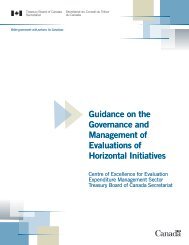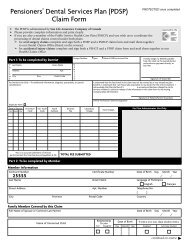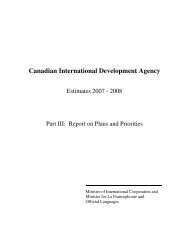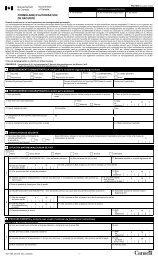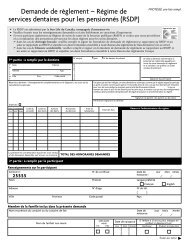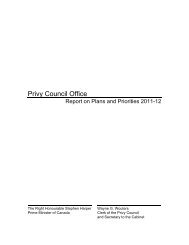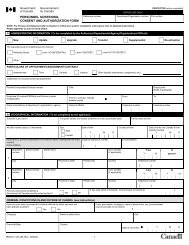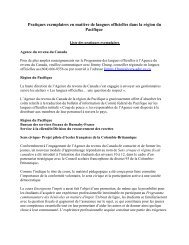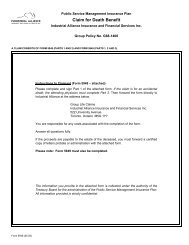Guide for the Development of Results-based Management and ...
Guide for the Development of Results-based Management and ...
Guide for the Development of Results-based Management and ...
You also want an ePaper? Increase the reach of your titles
YUMPU automatically turns print PDFs into web optimized ePapers that Google loves.
RMAF <strong>Guide</strong> August, 2001If successfully developed, <strong>the</strong> Framework should represent:an underst<strong>and</strong>ing between <strong>the</strong> partners on what <strong>the</strong>y aim to achieve, how <strong>the</strong>y plan towork toge<strong>the</strong>r to achieve it, <strong>and</strong> how <strong>the</strong>y will measure <strong>and</strong> report on outcomes;a tool <strong>for</strong> better management, learning <strong>and</strong> accountability throughout <strong>the</strong> lifecycle <strong>of</strong> apolicy, program or initiative; <strong>and</strong>an early indication that <strong>the</strong> policy, program or initiative is set up logically — with astrong commitment to results — <strong>and</strong> with a good chance to succeed.1.2 Why Do We Need a RMAF?The management framework <strong>for</strong> <strong>the</strong> federal government, <strong>Results</strong> <strong>for</strong> Canadians, sets up <strong>the</strong> expectationthat managers will focus on measuring progress toward <strong>the</strong> attainment <strong>of</strong> <strong>the</strong> results <strong>of</strong> <strong>the</strong>ir policies,programs <strong>and</strong> initiatives such that ongoing improvements can be made. The Treasury Board (TB) Policyon Transfer Payments 1 <strong>for</strong>malises <strong>the</strong> requirement <strong>for</strong> a RMAF as part <strong>of</strong> a TB submission, <strong>and</strong> <strong>the</strong> TBEvaluation Policy 2 indicates that <strong>the</strong>re are o<strong>the</strong>r occasions when a RMAF may provide benefits tomanagers, even when not required under <strong>the</strong> TB Policy on Transfer Payments.The Government direction <strong>and</strong> policy is to provide members <strong>of</strong> Parliament <strong>and</strong> <strong>the</strong> public with relevant,accurate, consolidated, <strong>and</strong> timely in<strong>for</strong>mation on how tax dollars are being spent <strong>and</strong> what Canadiansreceive as a result. The Government <strong>of</strong> Canada is committed not only to measuring <strong>and</strong> reporting onresults, but also to establishing clear st<strong>and</strong>ards against which actual per<strong>for</strong>mance will be reported.Three parliamentary instruments are crucial in working towards <strong>the</strong>se objectives. Departmental Reportson Plans <strong>and</strong> Priorities (RPP), which are tabled in <strong>the</strong> spring along with <strong>the</strong> government's Main Estimates,report on <strong>the</strong> rationale <strong>for</strong> initiatives <strong>and</strong> establish <strong>the</strong> strategic outcomes against which actualper<strong>for</strong>mance will be measured. Departmental Per<strong>for</strong>mance Reports (DPR) are Estimates documents,which are tabled in <strong>the</strong> fall. They report on achievements against <strong>the</strong> strategic outcomes that wereestablished in <strong>the</strong> departmental RPP. The third key document is Managing <strong>for</strong> <strong>Results</strong> which is also tabledeach fall, along with <strong>the</strong> DPR, as part <strong>of</strong> <strong>the</strong> “Fall Reporting Package.” This government-wide report onper<strong>for</strong>mance is now being refocused to summarise Canada's progress within a set <strong>of</strong> key societalindicators.1 http://www.tbs-sct.gc.ca/Pubs_pol/dcgpubs/TBM_142/ptp_e.html2 http://www.tbs-sct.gc.ca/pubs_pol/dcgpubs/TBM_161/ep-pe_e.html2



